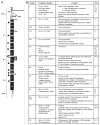The encephalomyocarditis virus
- PMID: 22722247
- PMCID: PMC3478238
- DOI: 10.4161/viru.20573
The encephalomyocarditis virus
Abstract
The encephalomyocarditis virus (EMCV) is a small non-enveloped single-strand RNA virus, the causative agent of not only myocarditis and encephalitis, but also neurological diseases, reproductive disorders and diabetes in many mammalian species. EMCV pathogenesis appears to be viral strain- and host-specific, and a better understanding of EMCV virulence factors is increasingly required. Indeed, EMCV is often used as a model for diabetes and viral myocarditis, and is also widely used in immunology as a double-stranded RNA stimulus in the study of Toll-like as well as cytosolic receptors. However, EMCV virulence and properties have often been neglected. Moreover, EMCV is able to infect humans albeit with a low morbidity. Progress on xenografts, such as pig heart transplantation in humans, has raised safety concerns that need to be explored. In this review we will highlight the biology of EMCV and all known and potential virulence factors.
Figures



References
-
- Dick GWA, Smithburn KC, Haddow AJ. Mengo Encephalomyelitis Virus. Isolation and Immunological Properties. Br J Exp Pathol. 1948;29:547.
-
- Roos RP. Pathogenesis of Theiler’s murine encephalomyelitis virus‐induced disease. Clinical and Experimental Neuroimmunology. 2010;1:70–78. doi: 10.1111/j.1759-1961.2010.00008.x. - DOI
-
- Knowles NJ, Hovi T, Hyypiä T, King AMQ, Lindberg AM, Pallansch MA, et al. Picornaviridae. In: Virus Taxonomy: Classification and Nomenclature of Viruses: Ninth Report of the International Committee on Taxonomy of Viruses. Ed: King AMQ, Adams MJ, Carstens EB, Lefkowitz EJ. pp 855-880. San Diego: Elsevier. 2011.
Publication types
MeSH terms
Substances
LinkOut - more resources
Full Text Sources
Other Literature Sources
